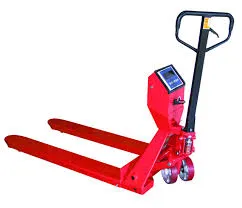


Understanding Manual Pallet Jacks A Comprehensive Guide
Manual pallet jacks, also known as hand pallet trucks, are essential tools in the warehousing, retail, and logistics sectors. They are designed to facilitate the movement of palletized loads with efficiency and ease. This article aims to provide an overview of manual pallet jacks, their features, benefits, and best practices for use.
What is a Manual Pallet Jack?
A manual pallet jack is a wheeled device that allows one person to lift and move heavy pallets. Constructed primarily from steel, they come with two forks that slide under the pallet, allowing the operator to lift it using a hydraulic pump mechanism. Unlike electric pallet jacks, manual variants require the operator to exert effort, making them suitable for environments where power sources may not be readily available.
Key Features
1. Fork Length and Width Manual pallet jacks are available in various fork sizes to accommodate different pallet dimensions. The standard fork length is usually around 48 inches, but custom options exist for specific applications.
2. Weight Capacity Most manual pallet jacks have a weight capacity ranging from 2,200 to 5,500 lbs, depending on the specific model. It's crucial to choose a jack that suits the load requirements to ensure safety and functionality.
3. Hydraulic Lift System Utilizing a hydraulic system allows the operator to lift heavy loads with minimal manual effort. They need to pump a handle to elevate the forks and thus the pallet.
4. Steering Mechanism Manual pallet jacks feature a steering wheel that allows for easy navigation around tight corners and narrow aisles. The wheels are often made from polyurethane or rubber, which enhances maneuverability and protects the floor from damage.
5. Durability Built from robust materials to withstand the rigors of daily use, manual pallet jacks are often finished with corrosion-resistant coatings to enhance longevity.
Benefits of Using Manual Pallet Jacks
1. Cost-Effective Manual pallet jacks are typically less expensive than their electric counterparts. They do not require batteries or electrical connections, making them a budget-friendly option for businesses.

2. Simplicity They are straightforward to operate. With minimal training, staff can learn how to use a manual pallet jack effectively, reducing the time and resources required for onboarding.
3. Versatility Manual pallet jacks can be used in various settings, including warehouses, retail spaces, and distribution centers. They are designed to handle standard pallets but can also handle non-standard loads with the right configuration.
4. Space Efficiency Because they are compact and designed for manual operation, they can easily navigate through small spaces, making them ideal for congested areas.
Best Practices for Using Manual Pallet Jacks
1. Inspect Before Use Always inspect the pallet jack for any signs of wear or damage before using it. Check the hydraulic system, wheels, and forks to ensure they are in optimal condition.
2. Proper Loading Ensure that the weight is evenly distributed on the pallet and that it does not exceed the jack’s weight capacity. This helps prevent accidents and equipment damage.
3. Safe Lifting When lifting a load, always pump the handle in a controlled manner. Avoid jerking motions that could destabilize the loads.
4. Throttle Control Use the throttle to lower the load gently and avoid sudden drops that may cause injury or damage.
5. Clear Pathways Ensure that the path is clear of obstacles when maneuvering with the pallet jack. This not only ensures safety but also enhances productivity.
6. Training Provide adequate training for all personnel who will operate the pallet jack. A well-trained staff will contribute to a safer working environment and improved operational efficiency.
Conclusion
Manual pallet jacks are vital for businesses requiring efficient handling of palletized goods. Their simplicity, cost-effectiveness, and versatility make them an ideal choice for many applications. By following best practices and understanding their features, operators can ensure a productive and safe working environment, maximizing the potential of this invaluable equipment. Whether it's in a bustling warehouse or a small retail store, mastering the use of manual pallet jacks can significantly enhance material handling processes.



